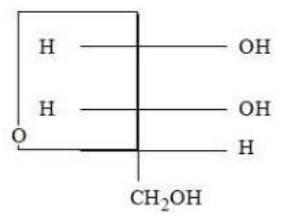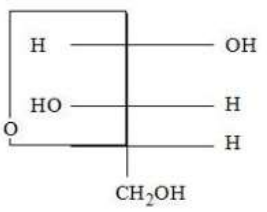L-isomer of tetrose X(C4H8O4) gives positive Schiff's test and has two chiral carbons. On acetylation, 'X' yields triacetate. 'X' also undergoes following reactions
'A'HNO3←−−−'X'NaBH4−−−−→'B'Chiral compound
'X' is




To solve the problem, we need to identify the compound 'X' based on the given information. Let's break it down step by step.
Step 1: Analyze the Molecular Formula
The molecular formula of 'X' is given as C₄H₈O₄. This indicates that 'X' is a tetrose, which means it has four carbon atoms.
Step 2: Identify the Structure of 'X'
Since 'X' is a tetrose and has two chiral carbons, we can start constructing its structure. The general structure of a tetrose can be represented as follows:
CHO|H−C−OH|H−C−OH∣CH₂OH
This structure has two chiral centers at the second and third carbon atoms.
Step 3: Confirm the Positive Schiff's Test
A positive Schiff's test indicates the presence of an aldehyde group. In our structure, the CHO group at the top confirms that 'X' has an aldehyde functional group, which is consistent with the positive Schiff's test.
Step 4: Acetylation Reaction
When 'X' undergoes acetylation, it yields a triacetate. This means that all three hydroxyl groups (OH) in 'X' are converted into acetate groups (OCOCH₃). The structure after acetylation would look like this:
CHO∣∣H−C−OCOCH₃∣∣H−C−OCOCH₃∣CH₂OCOCH₃
Step 5: Reactions with HNO₃ and NaBH₄
1. Oxidation with HNO₃: The reaction with HNO₃ will oxidize the aldehyde group to a carboxylic acid group. This will convert 'X' into a compound 'A' which has a carboxylic acid functional group at the top.
2. Reduction with NaBH₄: The reduction of the compound 'A' with NaBH₄ will convert the carboxylic acid to a primary alcohol. The resulting compound 'B' will still have two chiral centers.
Step 6: Conclusion
Based on the analysis, the compound 'X' that fits all the criteria (C₄H₈O₄, positive Schiff's test, two chiral carbons, and yields a triacetate upon acetylation) is D-erythrose.
Final Answer
'X' is D-erythrose.
---
The molecular formula of 'X' is given as C₄H₈O₄. This indicates that 'X' is a tetrose, which means it has four carbon atoms.
Since 'X' is a tetrose and has two chiral carbons, we can start constructing its structure. The general structure of a tetrose can be represented as follows:
A positive Schiff's test indicates the presence of an aldehyde group. In our structure, the CHO group at the top confirms that 'X' has an aldehyde functional group, which is consistent with the positive Schiff's test.
When 'X' undergoes acetylation, it yields a triacetate. This means that all three hydroxyl groups (OH) in 'X' are converted into acetate groups (OCOCH₃). The structure after acetylation would look like this:
1. Oxidation with HNO₃: The reaction with HNO₃ will oxidize the aldehyde group to a carboxylic acid group. This will convert 'X' into a compound 'A' which has a carboxylic acid functional group at the top.
Based on the analysis, the compound 'X' that fits all the criteria (C₄H₈O₄, positive Schiff's test, two chiral carbons, and yields a triacetate upon acetylation) is D-erythrose.
'X' is D-erythrose.
Topper's Solved these Questions
Similar Questions
Knowledge Check
- Question 1 - Select One
X in the following reaction is
Br2+CH3−C−H∣∣H−C−CH3CCl_4−−−→XA(+)2,3-DibromobutaneB(-)2,3-DibromobutaneC(±)2,3-DibromobutaneDmeso-2,3-Dibromobutane - Question 2 - Select One
Identify X and Y in the following reaction BCl3+NH4Cl140∘C/C6H5Cl−−−−−−−−−→XNaBH4−−−−→Y
AX=NaBO2,Y=B2O3BX=Na2B4O7,Y=H3BO3CX=BN,Y=[NH4]+[BCl4]−DX=B3N3H3Cl3,Y=B3N3H6 - Question 3 - Select One
For the sequence of reactions,
RC6H5NO2HNO3−−−→H2SO4A(NH4)2S−−−−−→B, the compound BisAAnilineBm- dinitrobenzeneCm- NitroanilineDm- diaminobenzene
Compound (X)C4H8O gives positive haloform test but does not give 2,4 DNP derivation is :
View SolutionWhat is X in the following sequence of reaction?
XNa−−−→1/2H2ZNaOH/CaO−−−−−−−→CH4↑⏐ ⏐ ⏐⏐View SolutionC8H6O4Δ−−→XNH3−−→Y
The compound XisView SolutionAn organic compound X(C4H8O2) gives positive test with NaOH and phenopthalein. Structure of X will be :
View SolutionAn organic compound X (C4H8O2) gives positive test with NaOH and phenophtalein. Structure of X will be :
View Solution

